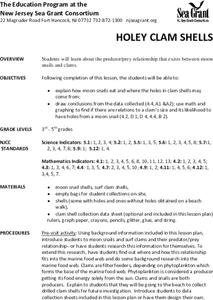Biology Junction
Dissection of the Clam
Is the structure of a clam really as simple as it seems? Young scholars explore the anatomy of the clam in an engaging lesson presentation. The lesson highlights the digestive process of the clam as well as how it moves and what it does...
Howard Hughes Medical Institute
Survival of the Fittest - Variations in the Clam Species Clamys sweetus
It's not often that you come across a clever laboratory activity that is both imaginative and comprehensive! Using M&M's and Reese's peanut butter candies to represent two different clam species, young biologists test for "relative...
Curated OER
Clam Challenge
In this clams learning exercise, students explore clam characteristics. Students complete nine multiple choice questions about clam facts.
Curated OER
Clam Vocabulary
In this clam vocabulary skills worksheet, students match the 9 clam-related terms in the word bank to the appropriate definitions.
Curated OER
Clam Crossword
In this clams crossword puzzle activity, students use the 10 clues and the terms in the word bank to help them correctly complete the word puzzle.
Curated OER
Clam Shell Data Collection Sheet
In this clam shell data worksheet, learners collect clam shells and identify their length, width, and if they have holes and not. They indicate the weather, wind direction, tidal stage, surface conditions, and beach conditions at the...
Curated OER
Beach Life: Clam Dissection
Learners investigate clams. In this clam life lesson, students conduct an experiment where they dissect clams. Learners compare anatomies of humans and clams.
Curated OER
Clam Anatomy
Students are introduced to the anatomy of the inside and outside of a clam before dissecting the animal. During the dissection, they label and identify the function of each part they see including the outside of the clam. They complete...
Curated OER
Clam Shell Data Collection Sheet
In this clam shell worksheet, young scholars collect data about 10 clams and measure their length and width. They identify if the clam has a hole or not in its shell and they indicate the location profiled, date, time of day, tidal stage...
Curated OER
Clam Word Search
In this clam vocabulary worksheet, students recognize words that relate to clams. Students complete the word search by finding all of the nine clam words.
Curated OER
Clam Hooping
Students explore ocean biology by capturing organisms on a beach. In this clam collecting lesson, students identify the clam species and discuss the anatomy of a clam as well as the importance they provide as a meal. Students utilize a...
Curated OER
Clam-Shell Concentration
Students discuss leisure activities of old Japan. They depict familiar stories or information through symbolic illustrations. Students decide upon game rules and interact in a positive manner while playing the game. They play...
Curated OER
Holey Clamshells
Students analyze data to make hypotheses and conclusions regarding the predator/prey relationship between moon snail and surf clams.
Curated OER
Comparing and Contrasting
Learners practice compare and contrast skills. In this science and language development lesson, students complete a T chart generating traits of a snail and a clam. Learners complete a related worksheet.
Curated OER
Clam Alphabet Activity
In this alphabet activity worksheet, students read the 9 words and alphabetize them. Students write the words onto the provided lines.
Curated OER
Bivalve or Univalve (Clam or Snail)?
Fourth graders explore the meaning of the prefixes "bi" and "uni." In groups, 4th graders observe pictures of shells and handle real shells. Students create a chart to classify each shell as a bivalve or univalve. They identify the...
Curated OER
Mollusks and Segmented Worms
Keep clam and read on! After reading the textbook selection about mollusks and worms in the additional materials section, your young zoologists check their comprehension by answering the questions on the handout found here. To...
Curated OER
CSI Clamshell Investigation
Students explore predator/prey relationships. They research information on moon snails and claims. Students draw conclusions from the data collected. They use math and graphing to determine if there is a relationship to the clam's size...
Curated OER
Activity 3: Using Photo Images to Explore Life on the Ocean Floor
Students work in groups with copies of the three photo images provided with the lesson. They make observations about mussels and clams. Students discuss reasons scientists use a representative sample of a population rather than the...
Curated OER
Word Search -am
In this word search worksheet, students find 15 words ending in "am." Words include clam, jam, slam, swam, scram, and ham.
Curated OER
Surprise Island Chapter 4-- Clamming
In this reading learning exercise, students answer 4 comprehension questions about Chapter 4 of Surprise Island. Students are given the first few words of the answer in italics to help them respond in a complete sentence.
Curated OER
Egret Maze
In this mazes worksheet, students determine the best path in a maze to help a great egret find a clam for supper. Students share their paths with their classmates.
Curated OER
CSI Clamshell Investigation
Pupils explore and explain how moon snails eat and where the holes in clamshells come from and then draw conclusion from the data collected. They incorporate math and graphing skills to determine if there is a relationship to a clam's...
Curated OER
Bivalve Biology
Students place clams into a beaker containing saltwater. They place a small drop of food coloring just above the shell. Students observe the movement of the food coloring. Clams are then placed into clean beakers of saltwater with 24...
Other popular searches
- Reproductive System of Clams
- All About Clams
- Dissecting Clams
- Clam Anatomy Worksheet
- Clambake
- Clam Dissection
- Clam Facts
- Clam Dissection Worksheet
- Clamp
- Life Functions of Clams
- Giant Clams
- Internal Anatomy Clam Model

























